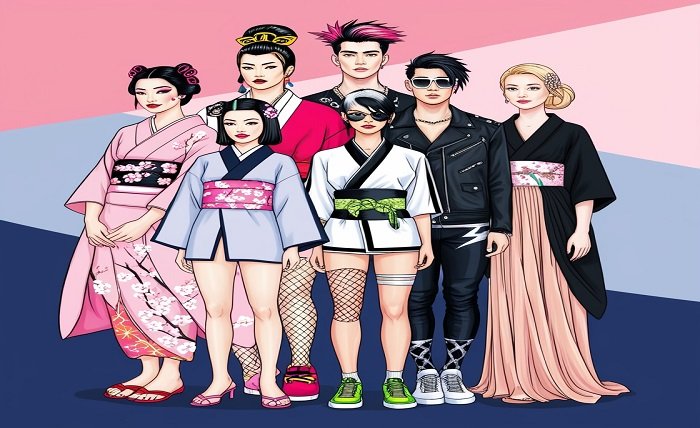Table of Contents
ToggleIntroduction
japanese fashion styles capture the spirit of a society that is both deeply rooted in history and constantly changing, offering a distinctive meeting point between tradition and innovation. Japanese clothing represents cultural ideals, artistic expression, and personal identity. Styles range from the elaborate kimonos of ancient times to the varied street fashion of modern Tokyo. Japanese fashion has captivated people all over the world because of its ability to combine different, local and international inspirations to create a rich, variegated tapestry that reflects the individuals who wear it.
Traditional Japanese Clothing
japanese fashion styles clothes have a strong cultural and historical foundation, and the clothes themselves frequently have a narrative of their own. This tradition’s signature garment is the kimono, whose elaborate designs and luxurious fabrics embody grace and craftsmanship. The yukata, on the other hand, is a more relaxed summertime option that is frequently worn during festivals and features eye-catching colors and whimsical patterns. The significance of dress in Japanese ceremonies is further demonstrated by the hakama, a ceremonial garment worn over the kimono that represents respect and tradition.
Modern Japanese Street Fashion
Modern japanese fashion styles bright display of individuality is most noticeable in the busy district of Harajuku. Here, style lovers create looks that frequently defy social norms by combining different styles in a kaleidoscope of hues, textures, and patterns. This scene is home to a variety of unique styles, including Lolita, which emphasizes modesty and wears clothing with Victorian influences, and Gyaru, which favors dramatic makeup and flashy attire.
Subcultures in Japanese Fashion
Japanese fashion is greatly influenced by subcultures, each of which has a distinct aesthetic and cultural importance. For instance, Visual Kei japanese fashion styles and music, with performers showcasing their theatrical presence through elaborate clothes and distinctive hairstyles. Fashion choices are often influenced by kawaii culture, which emphasizes cuteness and innocence via the use of pastel colors and amusing themes from manga and anime. Cyberpunk, on the other hand, is inspired by science fiction and presents a futuristic vision with metallic textiles and avant-garde styles.
Sustainable Japanese Fashion
As designers and brands realize the need for eco-friendly methods, sustainability has grown in importance in japanese fashion styles. To reduce their environmental effect, a lot of modern Japanese labels place a high value on ethical production practices, sustainable materials, and traditional workmanship. Eco-conscious business strategies have been adopted by Muji and Uniqlo, while smaller, independent designers frequently highlight handmade clothing that pays tribute to artisanal skills.
Influence of Japanese Fashion on Global Trends
There is no denying japanese fashion styles impact on international trends; its designers and styles have left a lasting impression on the world stage. Fashion icons like Issey Miyake, Yohji Yamamoto, and Rei Kawakubo have pushed the envelope by creating avant-garde notions that defy conventional wisdom and spark fresh insights. Fashion fans worldwide have found resonance in the distinctive aesthetics of Japanese street fashion, which is typified by bold expressions and fun layering. This leads to an exchange of cultural ideas and styles.
The Role of Technology in Japanese Fashion
Japanese fashion is deeply influenced by technology, which has a say in every aspect of the industry, from marketing to design. Cutting-edge materials that improve both functionality and aesthetics, such as breathable fabrics and smart textiles, are growing in popularity. japanese fashion styles are also using digital platforms to showcase their collections through interactive web content and virtual fashion shows, to reach a wider audience. Customers may now engage with clothing in ways that were previously unthinkable because of the merging of augmented reality (AR) and virtual reality (VR).
The Future of Japanese Fashion
japanese fashion styles appear to have a bright future since it will continue to prioritize innovation, sustainability, and cultural heritage. To create distinctive clothing that pays homage to the past while appealing to modern sensibilities, up-and-coming designers are increasingly experimenting with ways to combine traditional workmanship with contemporary aesthetics. A more conscientious attitude to fashion is being fostered by the growing movement among young designers to give ethical methods and environmentally friendly materials priority. as interest in Japanese subcultures and aesthetics grows on a worldwide scale.
Conclusion
japanese fashion styles capture the spirit of a tradition- and innovation-rich culture through its diverse and ever-changing terrain. Japan’s clothing reflects its history, ideals, and current challenges, from the lively expressions found in street fashion to the elegance of traditional garments like kimonos. Japanese fashion’s integration of technology and sustainability presents a bright future for the industry as it navigates new opportunities and challenges. japanese fashion styles inspire and enthrall audiences worldwide by embracing both its past and its future. Read more about: organic chemistry tutor face
FAQ
What constitutes traditional Japanese clothing’s essential components?
The kimono, obi (sash), and other layered items that represent seasonality and cultural value are common components of japanese fashion styles attire.
What effects has Japanese street fashion had on international trends?
Global fashion has merged influences due to the adoption of japanese fashion styles distinctive designs and aesthetics by fashion aficionados across the globe.
What role does Kawaii culture have in Japan?
Cuteness and innocence are emphasized in kawaii culture, which influences fashion, art, design, and lifestyle. This reflects a larger yearning for optimism in society.








